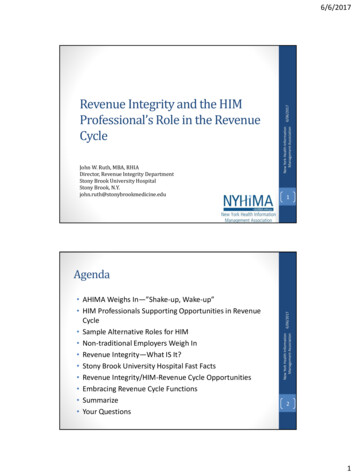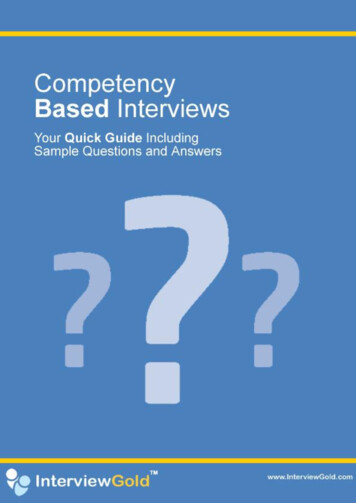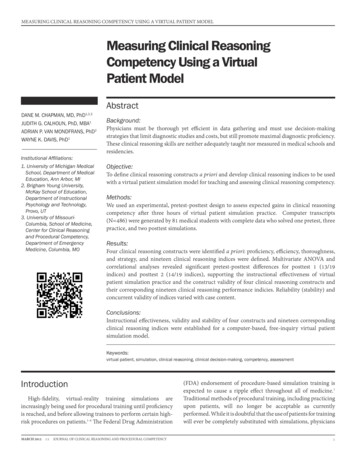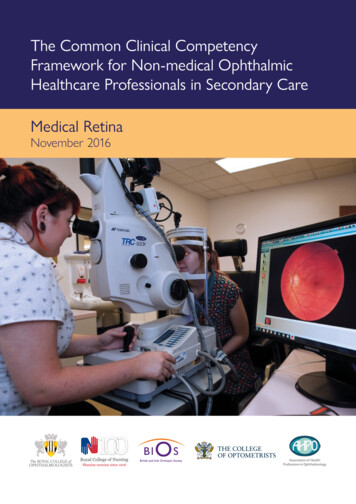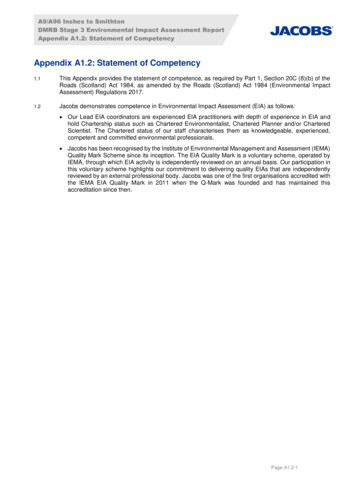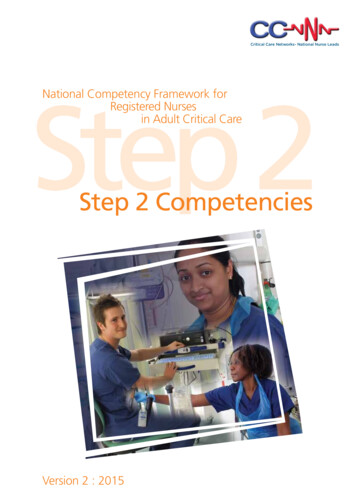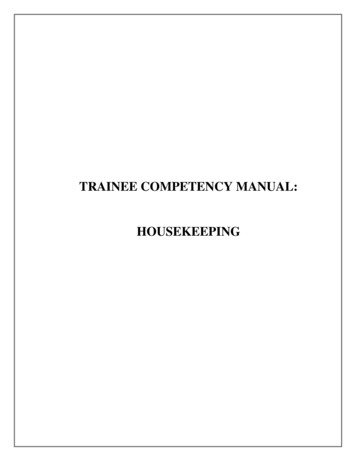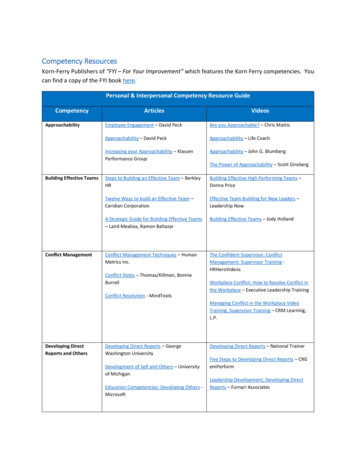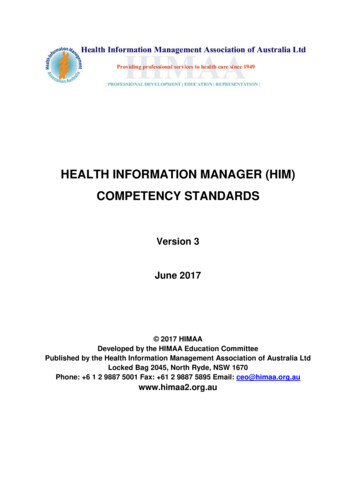
Transcription
HEALTH INFORMATION MANAGER (HIM)COMPETENCY STANDARDSVersion 3June 2017 2017 HIMAADeveloped by the HIMAA Education CommitteePublished by the Health Information Management Association of Australia LtdLocked Bag 2045, North Ryde, NSW 1670Phone: 6 1 2 9887 5001 Fax: 61 2 9887 5895 Email: ceo@himaa.org.auwww.himaa2.org.au
HEALTH INFORMATION MANAGER (HIM)COMPETENCY STANDARDSTable of ContentsBackground. 3Why HIMAA maintains professional competencies . 3What are HIMAA competency standards used for? . 5Domains and sub domains. 6A. Generic professional skills . 6B. Health information and records management . 6C. Language of healthcare . 7D. Healthcare terminologies and classification . 7E. Research methods . 7F. Health services organisation and delivery . 8G. Health information law and ethics . 8H. eHealth. 8I.Health information services organisation and management. 9Learning Levels . 9Table of Competencies . 11Acknowledgements . 31HIMAA – HIM Competency Standards Version 3 Board-approved 2 June 2017Page 2 of 31
BackgroundThe Health Information Management Association of Australia (HIMAA) is the peak professionalassociation representing health information managers.The Health Information Management Association of Australia promotes and supports healthinformation management professionals as the universally recognised specialists in informationmanagement at all levels of the healthcare system. We do this through positioning and advocacy,accreditation, education and training, certification and credentialing, quality standards, publicationsand resources, and HIMAA member networking activities at local and national levels, including anannual national conference of international standing. HIMAA defines a Health Information Manager as:A Health Information Manager (HIM) is a health information management professional witha HIMAA-accredited undergraduate or postgraduate university degree who plans,develops, implements and manages health information services, such as patientinformation systems, and clinical and administrative data, to meet the medical, legal,ethical and administrative requirements of health care delivery, or who teaches or doesresearch in these areas. 1Courses in Health Information Management accredited by HIMAA must encompass the profession'sentry-level elements of the HIM Competency Standards in their curriculum as a minimum requirementfor accreditation. Depending on their experience and professional development, a Health InformationManager may also have attained and applied some or all of the HIMAA Intermediate and AdvancedHealth Information Manager Competency Standards. These are not required for HIMAA graduateentry accreditation.Why HIMAA maintains professional competenciesHIMAA is responsible for the development of professional competency standards for HealthInformation Managers. The development and on-going enhancement of professional competenciesdefines the profession’s knowledge domain to inform third parties (e.g. Universities and employers) ofthe skills and knowledge that are required of new graduates and across the professional lifespan.Competencies provide the profession with the mechanism to formally feedback to the Universityprograms the level and nature of knowledge and skills that graduates require to function in theworkplace. One of the challenges in developing a set of competencies is to articulate what ‘should be’rather than describe ‘what is’. The intermediate and advanced competency standards address therequirements to develop and deliver ongoing competency based professional development topractising HIM professionals.Under its terms of reference, the HIMAA Education Committee has been delegated responsibility tooversee the development and continued refinement of competency standards for health informationmanagement.1Health Information Management Association of Australia 2015, Definition of the Profession,http://www.himaa2.org.au/index.php?q node/2438HIMAA – HIM Competency Standards Version 3 Board-approved 2 June 2017Page 3 of 31
In 2010 the HIMAA Education Committee commenced a review of the 2001 Version 1 entry-levelstandards, to ensure that competencies remained contemporary andthattertiary programs continued tograduate students with the professional skills and attributes required in the changing healthcareenvironment. The Version 2 result of this review was ratified by the HIMAA Board in 2013. In2013,theHIMAA Education Committee continued this program of work with the development of newintermediate and advanced competency standards. Version 3 refinement of the HIM competencystandards in 2017 has included a review of the Australian Qualifications Framework (AQF) 2,theAmerican Health Information Management standards 3,4,and other international HIM competencystandards 5,6,7,8In addition to Version 3 of this document, HIMAA has been involved in the development ofcompetency standards affecting the HIM profession: Development of the 1991 version of HIM competencies 9; Clinical Coder National Competency Standards and Assessment Guide published by theNational Coder Workforce Issues Project of the HIMAA in 1996 10; Representation on the1997National Records & Archives Competency Standards SteeringCommittee that produced nationally endorsed cross-industry Records & Archives CompetencyStandards; 2001 development of Version 1 of the Health Information Management CompetencyStandards, incorporating entry-level, intermediate and advanced competency standards forHealth Information Managers 11; Publication of Version 2 of the Health Information Management Entry-Level CompetencyStandards in January 2013 122Australian Qualifications Framework 2013, AQF specification for the Bachelor Degree.American Health Information Management Association 2005, Health Information Management Baccalaureate Degree EntryLevel Competencies – Domains, Subdomains and Tasks for 2005 and Beyond.4American Health Information Management Association 2011, Curriculum Map – Health Information ManagementBaccalaureate Degree.5International Federation of Health Record Organisations 2009, International HIM/HRM Model Curriculum.6Canadian Health Information Management Association 2010, Learning Outcomes for Health Information Managers –Degree/Diploma Program.7IMIA learning outcomes – knowledge/skill domains cited in International Medical Informatics Association Working Group 1:Health and Medical Informatics (2010) (First Revision). Recommendations of the International Medical InformaticsAssociation (IMIA) on Education in Biomedical and Health Informatics, Methods of Information in Medicine 391(2010) 267272 retrieved from https://www.ncbi.nlm.nih.gov/pubmed/200545028IMIA Knowledge Base (2009).9Health Information Management Association of Australia 1991, Policies and Standards for Approval of EducationalPrograms for Health Information Managers. Sydney, NSW.10Health Information Management Association of Australia 1996, Clinical Coder National Competency Standards andAssessment Guide. First Edition. Brisbane, Qld: National Coder Workforce Project.11Health Information Management Association of Australia 2001, Health Information Management (HIM) CompetencyStandards. Version 1. Sydney, NSW.12Health Information Management Association of Australia 2013, Health Information Manager (HIM) Entry-level CompetencyStandards. Version 2.0. Sydney, NSW.3HIMAA – HIM Competency Standards Version 3 Board-approved 2 June 2017Page 4 of 31
What are HIMAA competency standards used for?The purpose of entry-level competency standards is to provide a strong framework for coursecurriculum design and content, and to enable assessment of student and new graduate performancereadiness for profession entry. Professional accreditation is an integral part of the accreditationprocess for education programs in Health Information Management, and complements the academicself-accreditation processes of a registered university 13. Graduate entry courses in Health InformationManagement must encompass the profession’s entry-level elements of the HIM CompetencyStandards in their curriculum as a minimum requirement for accreditation. These entry-levelcompetencies also provide a framework for employers to establish the minimum skills and knowledgerequirements of new graduates.With ongoing technological advances and changes to the health system and work practices, thepurpose of the intermediate and advanced level competencies is to provide a strong framework foremployers to establish the minimum skills and knowledge requirements of experienced healthinformation management professionals (i.e. beyond entry-level), and also for use in professionaldevelopment initiatives. Intermediate and advanced competencies play a role in determining criteriafor awarding HIMAA’s Fellowship category of membership. HIMs working in specialist areas (e.g.environments such as mental health, community health, non-acute care, epidemiology, and research)may choose to develop a selection of intermediate and advanced competencies, relevant to their rolesand interests.In summary, the purpose of the HIM competency standards is to: Define the core skill set and knowledge domain of a HIM at entry, intermediate, and advancedlevels; Provide a framework for universities in curriculum development; Set minimum standards of competency for entry level HIMAA accreditation of university courses; Act as a guide for employers to the 'skill-set' an employer can expect as a minimum of a newgraduate and of an experienced HIM; Guide the development of position descriptions for employers; Guide continuing professional development and programs for individual HIMs; Provide a framework for professional development; and Support HIMAA Fellowship assessment.The HIM competencies are not intended to be used to measure workplace performance. The entrylevel competencies are generic whereas workplace position descriptions may be quite specific to aposition. Employee performance measuring tools are the jurisdiction of the workplace and may begoverned by employer policies and/or legislative requirements. Further, it is not intended that thecompetencies would result in a single national curriculum for programs in HIM. The competenciescommunicate to the HIM Course Co-ordinators the minimum competencies for new graduates. It iswithin the province of the educational institution how they develop these competencies in students.They may be utilised in graduate entry HIM courses as an adjunct to entry level competencies.13Universities Australia & Professions Australia2016, Joint Statement of Principles for Professional Accreditation, Canberra.HIMAA – HIM Competency Standards Version 3 Board-approved 2 June 2017Page 5 of 31
Domains and sub domainsThe competencies that make up the HIMAA HIM competency standards are organised into domainsand sub domains. The domains are categories covering a broad theme or branch of learning, with thesub domains relating to a particular topic within a domain.The competency tasks within each sub domain are specific competency statements for each HIMpractitioner level, as they apply to the management of health information systems and services.The domains and sub domains are described below:A.Generic professional skillsThis domain relates to professional skills that HIM graduates should be equipped with to enable themto fulfil a role as an HIM practitioner at entry level, intermediate and advanced levels.The sub domains cover the following attributes: Communication skills – the application of written, verbal, presentation, and interpersonal skillsappropriate to HIM practice Organisation and engagement Information communication technology (ICT) literacy and knowledge management skills Teamwork – within the work unit and as part of a multidisciplinary team Problem-solving and decision-making Lifelong learning Ethical behaviour Social and cultural awarenessB.Health information and records managementThis domain relates to the management of health data and records including structurein both manualand electronic formats, data collection, content, identification systems, retention, storage and retrieval,healthcare record functions, standards and regulations for documentation and legal aspects ofmanaging health information.The sub domains cover the following components of health data management: Health data and records - client and p
C. Language of healthcare This domain relates to the knowledge of medical science and medical vocabularies/terms essential to the understanding of information contained in the health record and related health information systems. The sub domains cover the following components of the language of health care:


